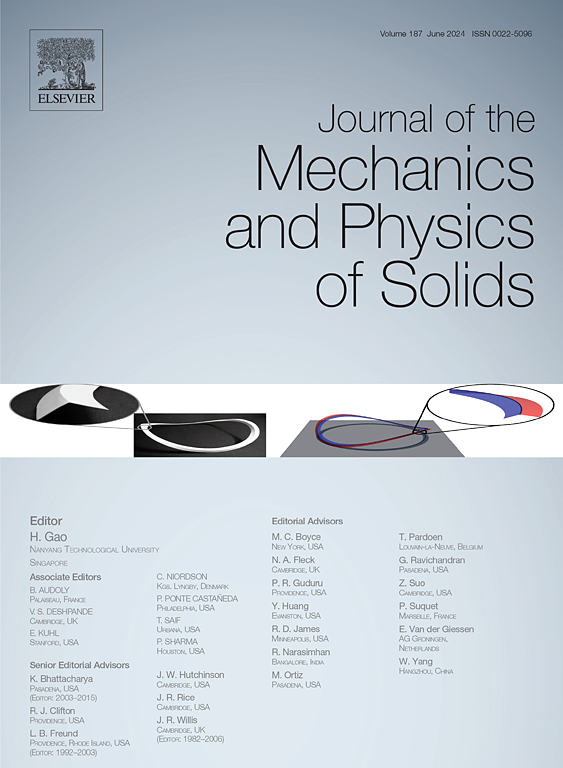满足普适逼近定理的各向同性多凸超弹性神经网络
IF 6
2区 工程技术
Q2 MATERIALS SCIENCE, MULTIDISCIPLINARY
引用次数: 0
摘要
本文提出了一种新的神经网络框架,该框架在满足普适近似定理的同时,施加了必要的物理和数学约束。两个关键成分是输入凸网络结构和变形梯度的符号奇异值的初等多项式公式。与先前发布的网络一致,它可以严格捕获帧无关性和多凸性,以及角动量平衡和生长条件等进一步的约束。然而,与以前的网络相比,本文证明了该方法的普遍近似定理。更明确地说,所提出的网络可以近似任何帧无关的、各向同性的多凸能量(前提是网络足够大)。这可以通过对框架无关的、各向同性的多凸函数进行充分和必要的判据来实现。通过与现有方法的比较研究,发现了该方法的优点,特别是在逼近非多凸能量和计算多凸包方面。本文章由计算机程序翻译,如有差异,请以英文原文为准。
A novel neural network for isotropic polyconvex hyperelasticity satisfying the universal approximation theorem
This paper presents a novel framework of neural networks for isotropic hyperelasticity that enforces necessary physical and mathematical constraints while simultaneously satisfying the universal approximation theorem. The two key ingredients are an input convex network architecture and a formulation in the elementary polynomials of the signed singular values of the deformation gradient. In line with previously published networks, it can rigorously capture frame-indifference and polyconvexity — as well as further constraints like balance of angular momentum and growth conditions. However and in contrast to previous networks, a universal approximation theorem for the proposed approach is proven. To be more explicit, the proposed network can approximate any frame-indifferent, isotropic polyconvex energy (provided the network is large enough). This is possible by working with a sufficient and necessary criterion for frame-indifferent, isotropic polyconvex functions. Comparative studies with existing approaches identify the advantages of the proposed method, particularly in approximating non-polyconvex energies as well as computing polyconvex hulls.
求助全文
通过发布文献求助,成功后即可免费获取论文全文。
去求助
来源期刊
CiteScore
9.80
自引率
9.40%
发文量
276
审稿时长
52 days
期刊介绍:
The aim of Journal of The Mechanics and Physics of Solids is to publish research of the highest quality and of lasting significance on the mechanics of solids. The scope is broad, from fundamental concepts in mechanics to the analysis of novel phenomena and applications. Solids are interpreted broadly to include both hard and soft materials as well as natural and synthetic structures. The approach can be theoretical, experimental or computational.This research activity sits within engineering science and the allied areas of applied mathematics, materials science, bio-mechanics, applied physics, and geophysics.
The Journal was founded in 1952 by Rodney Hill, who was its Editor-in-Chief until 1968. The topics of interest to the Journal evolve with developments in the subject but its basic ethos remains the same: to publish research of the highest quality relating to the mechanics of solids. Thus, emphasis is placed on the development of fundamental concepts of mechanics and novel applications of these concepts based on theoretical, experimental or computational approaches, drawing upon the various branches of engineering science and the allied areas within applied mathematics, materials science, structural engineering, applied physics, and geophysics.
The main purpose of the Journal is to foster scientific understanding of the processes of deformation and mechanical failure of all solid materials, both technological and natural, and the connections between these processes and their underlying physical mechanisms. In this sense, the content of the Journal should reflect the current state of the discipline in analysis, experimental observation, and numerical simulation. In the interest of achieving this goal, authors are encouraged to consider the significance of their contributions for the field of mechanics and the implications of their results, in addition to describing the details of their work.

 求助内容:
求助内容: 应助结果提醒方式:
应助结果提醒方式:


